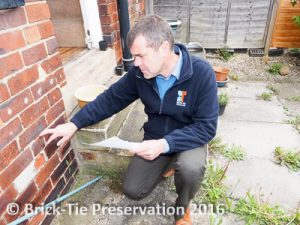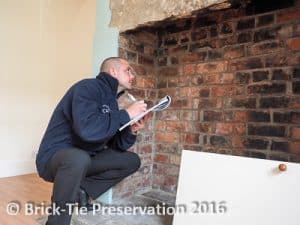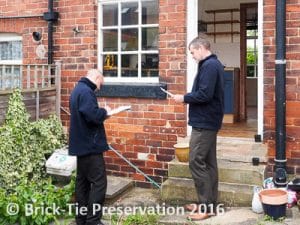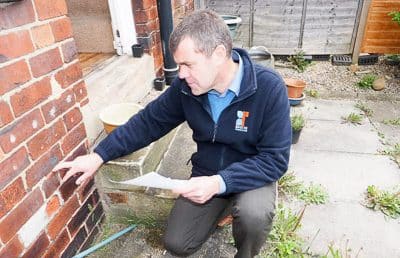Every month we like to have a day dedicated to surveyor training and CPD (Continuing professional development).
Today our three surveyors Bryan, Mike and Paul spent their time working together, to share their ideas and improve their skills. A joint survey was carried out in Horsforth. This was a 100 year old stone and brick terrace house with some old woodworm damage and some rising damp. This may seem basic stuff to spend time on. However, we believe that being good at the basics underpins every business; there is always something which can be improved. This is why we spend time on surveyor training.
The property had an old chemical DPC installed. However, the lads found that some of the walls were damp at the base, despite the ground levels being quite low in relation to the dampness. After careful profiling using a couple of different moisture meters a discussion was had. A detailed external inspection revealed that the Chemical DPC in the front wall was bridged by the existing solid floor. In other words the old chemical injection DPC had been installed in the wrong place! In addition, the front wall was a full 500mm thick, yet the remedial replastering was only applied to 1M high. This meant that a salt contaminated band of moisture was present just above that height.
The rear wall was brick and had no less than than two Chemical DPC installations – both injected into the dense brickwork, rather than the porous bed-joints. Mike tested the moisture content of the kitchen floor joists embedded in this wall and the levels were very high. There were signs that the kitchen floor had been partially replaced due to previous rot problems and woodworm infestation. The high moisture content Mike found in the floor timbers confirmed that it was still at high risk of decay – why?

There were also mould stains on the roof timbers in the loft, yet the timbers were dry. Mould needs moisture, so why was it there on dry timbers? Together the surveyors traced the problem to a bathroom, which had no extraction and spot lights in the ceiling. Lack of extraction causes excess humidity, but what have spotlights to do with it? Spotlights get hot and this creates an updraft, sucking air from the bathroom into the loft via the gap around the bulbs. The humid air created during showering is pulled into the cold roof space and condences there – ideal for mould growth. There was also some mould growth on the underside of the bathroom ceiling and the kitchen also lacked any extraction (there was a cooker hood, but it had no ducting kit so it just circulated humid air, rather than removing it).
The old chimneys were disused but were sealed up and dampness was present on the naked brick chimney breasts. The chimney stacks looked alright externally but the ridge tiles on the roof needed a re-point.
Our recommendation to our client

Various solutions and recommendations were discussed and a consensus reached, so advise could be given to our homebuyer client:
- Install a new Chemical diffusion DPC at the correct height and into the porous bed joints. Safeguard’s professional Damp Check Rod system was chosen because with two previous attempts being made to control rising damp, a fresh and more advanced water free option was essential
- Remove the salt contaminated plaster to the correct height of at least 500mm past the extent of contamination and replace it with a salt resistant type
- Improve the ventilation under the kitchen floor to reduce the high moisture content in the timber. No chemical treatments were needed as the lads all agreed that the woodworm was not active
- Recommend that the kitchen and bathroom have mechanical extraction installed to reduce excess humidity. Consider sealing the gap around the light fittings in the bathroom ceiling if they are remaining
- Ask a roofing contractor to re-point the ridge and install a couple of ridge vents to improve ventilation in the loft
- Our homebuyer was also informed that if the chimney flues are to remain disused they would need ventilating. In addition, any plans for replastering of the naked chimney breasts should include a salt resistant plaster
- Of course our client will have us to give them ongoing free advice once they move into their new house.
Why surveyor training is never ending

The above is a fairly average scenario when we carry out damp and timber surveys, especially for homebuyers. The defects seen above are common and sadly, it is not unusual to find that previous attempts at solving damp and timber defects have failed. This is partly due to a lack of surveyor training, so often clients call a damp and timber specialist and get an unqualified self-certified person. Sometimes they may find a qualified surveyor, but if they qualified years ago and haven’t kept up to date, mistakes get made. However, as in the case of the poorly ventilated kitchen floor, incorrect DPC levels and inadequate plastering, simple things can be missed because some people are just not that diligent. Our surveyor training days make sure we stay sharp for our clients.
The suveyors then ate fish and chips together at a local fish shop before visiting Kirkgate in Leeds. This time a commercial basement under a 17C listed building, where a waterproofing system was required, as part of a planned refurbishment. Bryan is CSSW qualified and took Mike and Paul through his assessment process, so the surveyors could consider the options for this important job.
Sometimes our training days are very technical with analysis and deep theoretical work. However, fundemental everyday surveying skill is crucial and like any skill it needs to be sharpened to stay at the cutting edge.
For great basic and not so basic damp, timber or basement waterproofing services call Bryan or Paul on Leeds 265 2752 York 566577 or Sheffield 224 5121 or email us via our contact page

